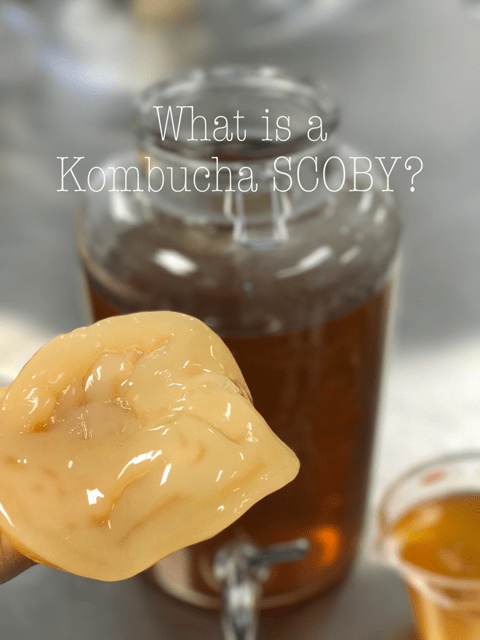


 Add to favorites
Add to favorites
 What the heck is a SCOBY Amie Sue? In my non-scientific tongue, I refer to it as being a big slimy blob of bacteria that is here to take over the world. But hey, that’s just me. To get really technical is it a beautiful arrangement of bacteria and yeast. “SCOBY” is actually an acronym:
What the heck is a SCOBY Amie Sue? In my non-scientific tongue, I refer to it as being a big slimy blob of bacteria that is here to take over the world. But hey, that’s just me. To get really technical is it a beautiful arrangement of bacteria and yeast. “SCOBY” is actually an acronym:
Symbiotic Culture Of Bacteria and Yeast… it is the mothership to millions of microorganisms. “Mom? Is that you?” The SCOBY is the heartbeat of kombucha making. It also seals off the fermenting kombucha from the air and protects it from the outside world and undesirable bacterias while it’s fermenting.
Yes of course! It’s a living organism and appreciates personal contact and love, just like you and I. BUT just make sure that your hands are clean… warning… don’t use anti-bacterial soap as it can adversely affect the SCOBY.
When handling a SCOBY you will find them soft, smooth, yet have a firm texture of… a squid? Have you ever handled a squid before? If not, it feels like a kombucha SCOBY. Lol Yea, I am a funny one. But seriously, they are a bit like us, we are tough but should always be handled with care.
I told you that they were taking over the world! Sorry, but I got to keep this all light-hearted because people get to weirded out by the process. Let’s have fun! Ok, back to business. Keep in mind that they are infinitely abundant as the “mother” produces a “baby” with each batch. It starts off looking like a thin film growing across the top of the mature SCOBY. It may first appear as little patches here and there on the existing SCOBY, but eventually, it will fill in forming a thin disc.
Eventually, after several batches, it will resemble a stack of pancakes. Once you hit about three or four SCOBYS, it’s probably a good time to start removing some. The ole cliche that bigger is better, again, not so. Bigger doesn’t equate to better kombucha, so don’t feel that you have to grow a trophy-sized SCOBY. There’s no real benefit to multiple SCOBYs in your jar either; it doesn’t brew any faster.
If you wish to share a SCOBY with friends, give them one that is roughly 6″ across and anywhere from 1/4-1/2″ thick. Be sure to add 1 -2 cups of matured kombucha to it, so they have what it takes to get started.
Well, outside of a vessel for its personal growth, I like to keep my brewing system in a well-ventilated area that holds a steady temperature. You also want to separate it from living plants and other fermenting that you may have going on. You can’t see it with the naked eye (or even a well dressed one), but there are organisms dancing all around you in the air. Let’s avoid cross-contamination. They also like warmer climates, ranging from 75-85 degrees (F). At times, it is challenging for me to keep the room at a consistently warm, cozy temperature, so I invested in a warming band to keep my kombucha in a constant state of being on a tropical vacation.